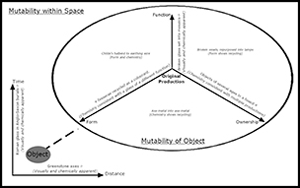Crossref Citations
This article has been cited by the following publications. This list is generated based on data provided by
Crossref.
Orfanou, V.
Birch, T.
Sindbæk, S. M.
Feveile, C.
Barfod, G. H.
and
Lesher, C. E.
2021.
On diverse arts: crucible metallurgy and the polymetallic cycle at Scandinavia’s earliest Viking town, Ribe (8th–9th c. CE), Denmark.
Archaeological and Anthropological Sciences,
Vol. 13,
Issue. 5,
Kershaw, Jane
and
Merkel, Stephen W.
2022.
Silver recycling in the Viking Age: Theoretical and analytical approaches.
Archaeometry,
Vol. 64,
Issue. S1,
p.
116.
Sands, Rob
2022.
Life beyond life: Repair, reuse, and recycle—the many lives of wooden objects and the mutability of trees.
Archaeometry,
Vol. 64,
Issue. S1,
p.
168.
Sainsbury, Victoria A.
and
Liu, Ruiliang
2022.
‘Nothing new under the sun’: Rethinking recycling in the past– Editorial.
Archaeometry,
Vol. 64,
Issue. S1,
p.
1.
Ahola, Marja
Holmqvist, Elisabeth
and
Pesonen, Petro
2022.
Materialising the Social Relationships of Hunter-Gatherers: Archaeological and Geochemical Analyses of 4th Millennium BC ‘Slate Ring Ornaments’ from Finland.
Journal of Archaeological Method and Theory,
Vol. 29,
Issue. 4,
p.
1259.
Holmqvist, Elisabeth
2022.
Why not let them rest in pieces? Grog‐temper, its provenance and social meanings of recycled ceramics in the Baltic Sea region (2900–2300 BCE).
Archaeometry,
Vol. 64,
Issue. S1,
p.
8.
Wood, Jonathan R.
2022.
Approaches to interrogate the erased histories of recycled archaeological objects.
Archaeometry,
Vol. 64,
Issue. S1,
p.
187.
Chirikure, Shadreck
2022.
Recycling and the material science tetrahedron: Everyday strategies of making in high temperature technologies of Iron Age southern Africa.
Archaeometry,
Vol. 64,
Issue. S1,
p.
26.
Bray, Peter
2022.
Is a focus on ‘recycling’ useful? A wider look at metal mutability and the chemical character of copper alloys.
Archaeometry,
Vol. 64,
Issue. S1,
p.
87.
Pollard, A.M.
2023.
Handbook of Archaeological Sciences.
p.
953.
Fiorentino, Sara
and
Chinni, Tania
2023.
The Persistence of Memory. Exploring the Significance of Glass from Materiality to Intangible Values.
Heritage,
Vol. 6,
Issue. 6,
p.
4834.
Bentley, McKenzie R.
Gilmour, Brian
and
Pollard, A. Mark
2023.
‘The sword that was broken …’: The detection of recycled iron in the archaeological record.
Archaeometry,
Vol. 65,
Issue. 6,
p.
1260.
Knapp, A. Bernard
2023.
“And in Length of Days Understanding” (Job 12:12).
p.
1303.
Chinni, Tania
Silvestri, Alberta
Fiorentino, Sara
and
Vandini, Mariangela
2023.
Once upon a Glass—Cycles, Recycles and Reuses of a Never-Ending Material.
Heritage,
Vol. 6,
Issue. 1,
p.
662.
Borgo, Francesca
and
Ezra, Ruth
2024.
Discards by Design: Recovering Waste in the Making.
West 86th: A Journal of Decorative Arts, Design History, and Material Culture,
Vol. 31,
Issue. 1,
p.
5.
Voulgari, Evangelia
Sofronidou, Marina
and
Kotsakis, Kostas
2025.
Flows, transformations, and temporalities in pots life history: The case of Neolithic Dispilio, North Greece.
Journal of Archaeological Science: Reports,
Vol. 66,
Issue. ,
p.
105308.
Quirós Castillo, Juan Antonio
2025.
Arqueología de las identidades locales. La producción de localidades en el noroeste peninsular en la Alta Edad Media.
Journal of Medieval Iberian Studies,
Vol. 17,
Issue. 3,
p.
337.


